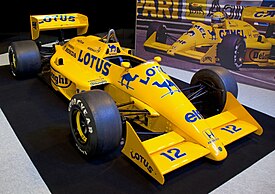Lotus 99T
 |
|||||||||||
| Category | Formula One | ||||||||||
|---|---|---|---|---|---|---|---|---|---|---|---|
| Constructor | Team Lotus | ||||||||||
| Designer(s) |
Gérard Ducarouge Martin Ogilvie |
||||||||||
| Predecessor | 98T | ||||||||||
| Successor | 100T | ||||||||||
| Technical specifications | |||||||||||
| Chassis | Carbon fibre and Kevlar monocoque | ||||||||||
| Suspension (front) | Lotus Active, double wishbones, coil springs | ||||||||||
| Suspension (rear) | Lotus Active, double wishbones, coil springs | ||||||||||
| Axle track | Front: 1,791 mm (70.5 in) Rear: 1,641 mm (64.6 in) |
||||||||||
| Wheelbase | 2,730 mm (107 in) | ||||||||||
| Engine | Honda RA166-E, 1,494 cc (91.2 cu in), 80° V6, turbo (4.0 bar limited), mid-engine, longitudinally mounted | ||||||||||
| Transmission | Lotus-Hewland 6-Speed manual | ||||||||||
| Weight | 540 kg (1,190 lb) | ||||||||||
| Fuel | Elf | ||||||||||
| Tyres | Goodyear | ||||||||||
| Competition history | |||||||||||
| Notable entrants | Camel Team Lotus Honda | ||||||||||
| Notable drivers | 11. 12. |
||||||||||
| Debut | 1987 Brazilian Grand Prix | ||||||||||
|
|||||||||||
| Constructors' Championships | 0 | ||||||||||
| Drivers' Championships | 0 | ||||||||||
The Lotus 99T was a Formula One car designed by Gérard Ducarouge for Lotus for use in the 1987 season. After Renault pulled out of F1 at the end of 1986, Lotus signed a deal with Honda for use of their turbocharged 1.5-Litre engine, although due to Honda's already existing deal with the Williams team allowing them exclusive use of the 1987 spec Honda RA167-E, Lotus had to make do with the Honda RA166-E spec engine from 1986. As part of the deal, Lotus agreed to sign Honda's test driver Satoru Nakajima as team mate to Ayrton Senna. Nakajima, who many felt was only in F1 because of his nationality and because of Honda, brought little to the team other than Honda.
Lotus had also lost long time major sponsor John Player Special who were replaced by Camel as title sponsor, meaning the black cars with gold sign writing of the previous seasons were replaced by bright yellow with blue sign writing.
The 99T was the second Lotus chassis to be fitted with electronic active suspension after the team had experimented with the system on the Lotus 92 used in the first part of the 1983 season. The system's benefits of a consistent ride height with no pitch or roll in the chassis came at a cost, as the system added significant weight to the car (approx 25kg or 55lb) and also robbed the Honda turbo of approximately 5% of its power (the RA166-E was rated at approximately 800 bhp (597 kW; 811 PS) with 1987s 4.0 Bar turbo boost restriction). Ducarouge clawed as much performance back by spending many hours in the wind tunnel to compensate, although by the end of the season Senna was describing the car as nothing more than the previous year's 98T with a Honda engine instead of the Renault, and there were few in the F1 paddock outside Lotus who disagreed with him. The 99T was generally regarded as the more bulky of the cars that won a Grand Prix in 1987 with the Williams FW11B, McLaren MP4/3 and Ferrari F1/87 all regarded as better aerodynamically than the Lotus. Despite this, the 99T (especially in Senna's hands) was often among the fastest cars in a straight line.
...
Wikipedia
